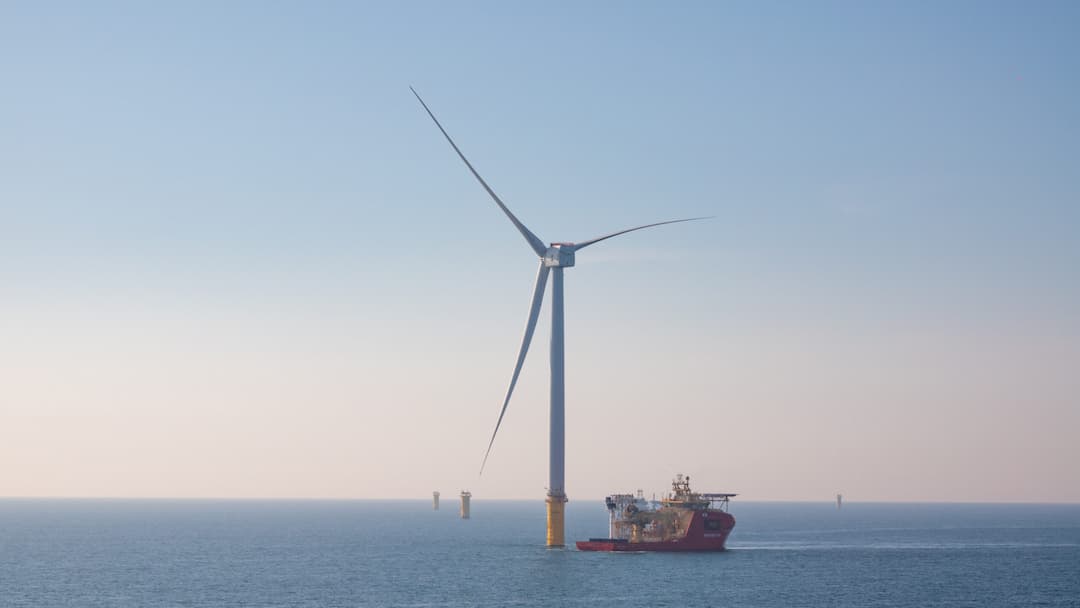This blog was written by Omer Khalid, Analyst, Analysis & Insights – ORE Catapult
When it comes to offshore wind, the UK has not only weathered challenges but emerged as a frontrunner in the last decade. 2023 saw the momentum continue as major capacity milestones were reached, new projects progressed, and the UK Government firmed up ambitious plans for long-term growth. Yet existing challenges around project delays, Contracts for Difference (CfD) pricing, and supply chain bottlenecks persist. As the UK looks forward to 2024 and beyond, resolving these issues while assessing the offshore wind value chain from a holistic perspective will be the key to project delivery along with maintaining leadership amidst rising international competition.
Power Behemoths Come Online
The flagship achievement this year was the start of the electricity production from the 3.6 GW Dogger Bank wind farm off the Yorkshire coast following the installation of an industry-first Haliade-X 13MW turbine, which was tested at our world leading specialist facility in Blyth, Northumberland. At 1.2 GW per phase, each of Dogger Bank’s three phases currently represents the world’s largest offshore wind farm. The first power milestone marks the first of what will eventually be 277 turbines powered-up across the project. Each of these turbines will be progressively commissioned between now and full commercial operation due in 2026. When complete, Dogger Bank will be more than two and a half times the size of the largest offshore wind farm currently in operation. 2023 also saw Scotland turning-on one of its largest, and world’s deepest fixed-bottom offshore wind farm to date, the 1.1GW Seagreen offshore wind farm.
Teething Issues Endure
Even as capacity and investments grew steadily, project delays, regulatory uncertainty around grid connections along with financial and supply chain constraints continued hampering faster deployment. The industry has faced a double economic blow that has compounded costs. First, the cost of building and installing wind turbines has increased due to the price of materials rising sharply, owing to the geopolitical and trade headwinds. Then, the cost of borrowing money to finance the multibillion-pound projects has climbed in line with global interest rates. Norfolk Boreas wind farm, off the coast of Norfolk, was halted by the lead developer Vattenfall due to spiraling supply chain costs and rising interest rates which rendered the project being no longer profitable, with the CfD it was awarded.
Recently, major turbine OEMs have also been dealing with a spate of reliability issues. This has impacted Kincardine, the largest floating offshore wind demonstrator project, as, due to insufficient port infrastructure, a turbine had to be towed to Rotterdam for major component replacements. The UK also continues struggling with a shortage of specialized crew vessels to service and maintain the exponentially growing fleet of offshore turbines.
Perhaps the most eye catching development was that Allocation Round 5 (AR-5) of the CfD process failed to attract any bids from eligible offshore wind projects. This was viewed by many as the inevitable result of prices that did not match up with the economic reality facing offshore wind developers. For the upcoming AR-6 auction due to be opened in March 2024, the maximum Administrative Strike Price (ASP) has been increased by 66% for offshore wind projects, from £44/MWh to £73/MWh, and by 52% for floating offshore wind projects, from £116/MWh to £176/MWh (in 2012 reference prices). Offshore wind will get its own “pot” in AR-6 which is a very welcome development. Furthermore, there are consultations to add “non-price factors” into the ARs from 2025 onwards. Meaning projects may be awarded more money if they reduce carbon emissions in their supply chains and demonstrate positive social impact on communities. These auctions , with an aim of 3-5 GW per AR, may add capacity topping 30-50 GW over the next decade. Other positive tailwinds include investments in port infrastructure upgrades, local manufacturing expansion, and major offshore site surveys kicking off across the Celtic Sea, North Sea, and Pentland Firth.
Global Competition Heats Up
If not properly tackled, these challenges around project delivery and supply chain could potentially threaten UK’s offshore wind leadership in the years to come, as competition from Asian and European countries heats up. China now has the world’s largest installed offshore wind capacity base after explosive growth since 2015. Its pipeline of approved future projects also dwarfs the UK’s targets. Closer to home, other North Sea economies like the Netherlands, Germany, and Norway recorded higher installations than Britain this year. Ensuring clear visibility over future leasing rounds and contracts, while attracting investments into manufacturing and ports will help the UK maintain momentum in the growth of domestic offshore wind and help us to keep our world leader status. The UK Government’s plans to establish at least four low-carbon industrial clusters by 2030 focuses on some of these objectives. As the UK offshore wind industry transitions from the plucky upstart to an industrial powerhouse this decade, it must demonstrate the vision and execution to justify its global leader ambitions.

Looking ahead, 2024 is lined up to be another promising year as the UK seeks to push ahead to get towards its ambitious target of 50 GW in offshore wind capacity by 2030. The industry’s trade association RenewableUK predicts speedier progress on installations across 7 major new wind farms with a combined capacity of 7.8 GW. Dogger Bank’s second phase is also expected to start generating first power sometime next year. Furthermore, the UK Government’s recent plan to cut the average delay time projects face to connect to the grid from 5 years to just 6 months could bode well for unlocking speedier commissioning of wind farms.
